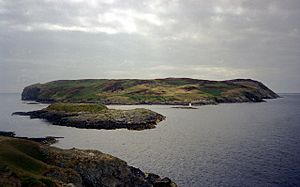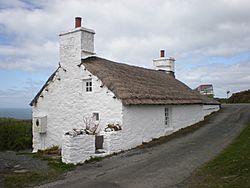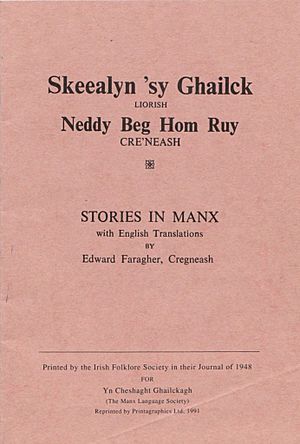Edward Faragher facts for kids
Quick facts for kids
Edward Faragher
|
|
|---|---|

Edward Faragher outside his home in Cregneash
|
|
| Native name |
Ned Beg Hom Ruy
|
| Born | 1831 Cregneash, Isle of Man |
| Died | 5 June 1908 (aged 76–77) Blackwell Colliery, near Alfreton, Derbyshire, England |
| Occupation | Fisherman |
| Nationality | Manx |
| Period | Victorian, Edwardian |
| Genre | Poetry, folklore, memoir |
| Subject | Manx legends |
Edward Faragher (1831–1908), also known by his Manx name Ned Beg Hom Ruy, was a special poet and storyteller from the Isle of Man. He wrote in the Manx language and collected many old Manx stories. People remember him as the last important native writer of Manx. He also helped protect Manx culture when it was in danger of being lost.
A folklorist named Charles Roeder said that Faragher did "great services to Manx folklore." He helped save many valuable Manx legends. Because of him, the Isle of Man will always be grateful.
Contents
Early Life (1831–1876)
Edward Faragher was born in 1831 in Cregneash. This was a fishing village in the south of the Isle of Man. He was one of twelve children in his family. At that time, most people in Cregneash spoke only Manx. His mother was special because she could speak English, so she talked to visitors.
Edward's father, known as Ned Hom Ruy, was one of the few people in the village who could write. He often wrote letters for other villagers. Edward's Manx name, Ned Beg Hom Ruy, came from his father. "Beg" means "little" in Manx, so it means 'Little Ned with the Red Beard'.
Edward went to school for only two years because his family could not afford more. He learned the rest from his parents or by teaching himself.
When he was young, Edward started working as a fisherman on his father's boat. He fished for seven years. Then, he moved to Liverpool, England, to work in a factory that made safes.
Edward enjoyed his time in England. He was good at writing poems, and young women liked his songs. In 1899, he wrote that his songs made the young women very excited. He said they would read his songs to their friends, and then everyone wanted him to write a song for them.
While in Liverpool, when he was about 26, Edward started writing down his poems for the first time. Before this, he had only kept them in his head. Even though he liked Liverpool at first, he eventually wanted to go back home. He wrote a poem called A poem about things I have seen in Liverpool, where he said:
- Farewell to phantasy and art
- That never can fill up my heart,
- And those fair maids, with witching smile,
- No more can my sad heart beguile;
- For still my fancy lingers where
- The youthful Kitty blooms so fair,
- And father tills my native soil
- Among the hills of Mona's Isle.
This poem shows how much he missed his home, the Isle of Man, also called Mona's Isle.
Life as a Fisherman (1876–1889)

Edward Faragher returned to Cregneash around 1876. He continued to work as a fisherman, catching mackerel near Kinsale and off the west coast of Ireland. During his fishing career, he faced dangerous storms and was even shipwrecked, but he always survived. In his middle age, he got married and had children.
After returning to the island, Edward began to write many poems and hymns. He wrote about 4,000 songs or poems in both Manx and English. His poetry changed from romantic topics to more thoughtful and sacred ones.
Even though he wrote so much, people in his own village did not pay much attention to his poems. Sometimes, his friends and other villagers even made fun of him.
Becoming a Folk Hero (1890–1899)
In the 1880s or 1890s, Edward Faragher met Charles Roeder. Roeder was a German folklorist who lived in Manchester. Roeder quickly saw how important Edward was. He was a great source of old stories and cultural knowledge. He was also one of the best Manx language speakers on the island. This was very important because the Manx language and culture were fading away. Older people were dying, and younger people were not interested.
Roeder and Faragher started writing many letters to each other. Roeder sent Faragher empty notebooks to fill with old stories and legends. A strong friendship grew between them that lasted until Faragher's death.
Through Roeder, Edward Faragher became well-known among people who cared about Manx culture. He met important figures in the Manx cultural revival, like Sophia Morrison and John Kneen. People from outside the island also became interested in Faragher. His letters to Roeder mention visits from people who had heard about him in London. He also met academics, like a professor from Scotland who spoke with him in Scottish Gaelic.
In 1896, so many people from other places were interested in Faragher that he wrote he was "kept busy answering young ladies letters ones that I never saw."
However, some local people in Cregneash did not like all the attention Edward was getting. They felt he was drawing too much notice to himself and the village. This made things difficult for him in his community. Roeder even had to publish notes in newspapers to try and calm the situation.
Edward also faced tough times making a living. In the 1890s, it became harder for him to earn money as a fisherman and a small farmer. In 1898, he wrote that fishing was difficult, and they sometimes could not catch enough mackerel to eat. By then, Edward was in his 60s and suffered from rheumatism, which made it hard to work. He also felt that farmers paid very low wages. He wrote a poem about this, saying:
| A Song About Farmers [extract] | |
|---|---|
|
Very little do they give the poor labourer
|
Roeder tried to get public support for Faragher. He hoped to raise money to help him. In 1898, he asked the famous Manx novelist Hall Caine to write about Faragher. But Caine did not think Faragher's poems were special enough to get a lot of attention. He said Faragher was a good man who loved his island, but his poems were not remarkable as literature. Because of this, a public fund was never created for Faragher.
Publishing His Work (1900–1907)
Thanks to Charles Roeder, some of Edward Faragher's writings started to be printed in the early 1900s.
Sometimes, his poems appeared in newspapers. But his only book published during his lifetime was his Manx translation of Aesop's Fables. Faragher had translated other stories before, like The Ugly Duckling. Roeder encouraged him to translate all 313 Aesop fables. He finished them in four months in 1901, even though he was not well.
A publisher in Douglas printed 25 of these fables in 1901. The book was called Skeealyn Aesop. They planned to publish more, but not enough people bought the first book. Roeder knew the work was important, so he put Faragher's full manuscript in the Manx Museum library for safekeeping. It is still there today.
Skeealyn Aesop also included some of Faragher's poems and a description of old Cregneash. One poem, Verses Composed at Sea Some Twenty Years Ago, showed his deep love for his home:
- Mona, where I have slept,
- Mona, where I have toiled,
- Mona, where I have wept,
- Mona, where I have smiled,
- My native cot, still dear to me,
- I wish to rest in death near thee.
Faragher also wrote down many memories of old folk beliefs, stories, and traditions. These were printed in Charles Roeder's newspaper column, Manx Notes and Queries. This column ran from 1901 to 1903. Later, the column's content was published as a book in 1904. However, like Skeealyn Aesop, the book did not sell well because the Manx public was not very interested.
This lack of interest also affected his poetry. While some newspapers published his poems, many others refused them. His poems were described as "homely" and appealing to "simple emotions."
Even though Roeder and others knew how important Faragher was, they were sad that people did not show enough interest in his work during his lifetime. After Faragher died, Roeder wrote that he was "a very disappointed man" and felt "shabbily served by the Manx people who ignored him."
Later Years (1907–1908)
By early 1907, life in Cregneash was very hard. Edward Faragher's daughter, who was a widow, and her two sons had to move to Canada. She had been taking care of him since his wife died. So, Edward, who was 76, had to leave the island. He went to live with his son, W. A. Faragher, in Derbyshire, England.
Edward was very sad to leave the Isle of Man. He tried to stay connected by reading The Isle of Man Examiner newspaper, which Roeder sent him every week. He wrote to Roeder, saying sadly, "I am not longing for much but a sight of the sea." He wrote many poems at his son's house until he became ill. His son said, "He has been writing verse since he came here until his head got bad, and now he says he shall write no more."
One of his most powerful poems from this time was about his sadness over the decline of Manx culture:
| Dear Little Mannin [extract] | |
|---|---|
|
Nevertheless, I am saddened for the mother tongue
|
Less than 18 months after leaving the island, Edward Faragher died from a painful illness on June 5, 1908. He was buried in an unmarked grave in Derbyshire.
In his obituary for Faragher, Charles Roeder wrote that no one loved the Isle of Man as much as he did. He said Faragher knew so much about Manx traditions and sang about the island's beauty. Roeder added that it was thanks to Faragher that so much traditional folklore was saved.
Legacy
Today, people understand how important Edward Faragher was, just as Roeder did during his lifetime. His poems and stories are now reprinted and used by people learning the Manx language. In 2010, he was included in an important book of Manx literature called Manannan's Cloak. This showed his high status as a Manx poet.
His old home in Cregneash is now part of the Manx National Heritage folk museum. In 2008, on the 100th anniversary of his death, a curator from Manx National Heritage said that the true value of Ned Beg's work to save Manx culture became clear only after he died.
|



